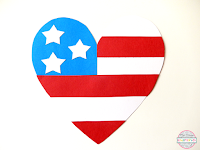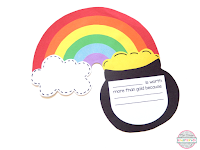Kindergarten has changed so much since I was in Mrs. Ryan's half day class back in the 80's. Kindergartners have gone from playing house to being expected to read and write by the end of their first year in school full time. While I could debate the merits and pitfalls of these changes at length I prefer to focus on how to incorporate more of this creative energy alongside the push for academics.
I was fortunate to teach in schools that still had full time art teachers that saw my students on a weekly basis so I knew they were getting solid art instruction regularly, however I feel that in kindergarten especially the need to practice writing, painting, coloring within the lines and cutting with scissors is essential for fine motor development. One of the ways that I integrate arts alongside my instruction is through the use of paper crafts, often called craftivities, that accompany our read alouds, comprehension and writing work.
These crafts require students to really focus their attention to building strong scissor skills which help in so may aspects of a child's development. If you have an administrator or even parent that is less than enthusiastic about your cute little paper crafts lining the walls and wants to know how this could possibly be helping students, then I have a little one page info sheet that you can quietly slip into their mailbox or backpack. (Click on the image to download a printable copy.)
If you need some really great advice for helping those kiddos in your class that have never picked up a scissors before entering your classroom and you don't know where to start with them, Mama OT is a FANTASTIC resource for parents and teachers, I use lots of her ideas with my 3 year old all the time.Here are just a few of my favorite craftivities. Click on the pictures for the printables!


Thanks for reading and happy crafting!










As a lifetime primary teacher I heartily concur with the above advise about the importance of learning to cut well (with good quality scissors) as an important motor and eye-hand coordination skill. Not only does it help with fine motor control that is helpful for learning to print, but prepares a child to handle many hand tools with better dexterity. I like the trick to keep elbows down close to the body when cutting! That being said, it is very important to ensure the scissors made available to the children include some that can be operated effectively by those who are left handed. If you are right handed and would like to know how it feels to the left-handed child to cut with right handed scissors, try a pair of left-handed scissors and you will see how the cutting edge of the blades seem to slip way along the paper in a way that makes cutting next to impossible. I checked good quality children's scissors online and see that both handed types are available - and that some scissors are actually designed to cut equally well with either hand. Holding the scissors correctly (as are pencils for printing) is important too. To operate scissors hold the handles so your thumb is in the top handle loop and your ring finger is in the bottom handle loop, with the blunt side of the bottom blade being cradled on the inside of your middle and pointer finger. This way your hand can relax and the pointer finger can guide while your wrist action can determine the direction of the cut. We always started with straight cuts, but learned to master curved cuts as well. Whichever hand is not in the scissors (the other one!) plays the essential role of holding the paper and turning it in concert with the closing blades for smooth curves. To make a cut that it is reasonably straight or one that requires continuous cutting be sure to open the scissor blades sufficiently wide (while remaining comfortable in your hand) then AIMING as you close the blades smoothly rather than trying a series of snips with the blades only slightly open. Work to cut straight lines, curves, zigzags (the latter require smaller snips with the scissors still using the wider open position) with increasing finesse. By the end of first grade (when their muscles are developmentally ready) children should learn how to cut into tight corners with tip end snips to remove small bits - tricky but effective - and how to cut the center out of a doughnut. First of all cut the outside of the circle to get rid of excess paper, then pinch and snip with the tips to create a hole in the center of the center. Insert bottom scissor blade into the hole and cut toward the edge of the circle - to the line that is indicated as the inside of the doughnut. Rotate the circle to make several cuts radiating from the center snip to the inside line and then carefully fit the scissor blades to cut along the line to free the tags created by cutting radially. Organize a graduating series of cutting skills through art and craft projects as that makes it fun and gives the children a finished product they can enjoy. Not everyone is naturally as dexterous as some - so lots of encouragement and support can help the most reluctant cutter improve with practice - use paper from the recycle box or newspaper flyers. Cutting a circle and then making a spiral was one of our favourite cutting projects. Done with green paper it became a neat 'mobile' on which to perch a ladybug or butterfly and suspend. Of course cutting shapes such as a butterfly (or heart) was a folding and cutting lesson in symmetry - one that combined with small shape cutouts eventually led to snowflakes the following winter. One last suggestion... scissors left in some little hands can become rather mischievous. Sometimes best to store in a central spot that can be monitored so little hands armed with cutting instruments do not snip into books - or even their own hair or that of another classmate - yikes! It turns out that when I think of it there is a lot to learn about cutting for small children!!!!
ReplyDelete